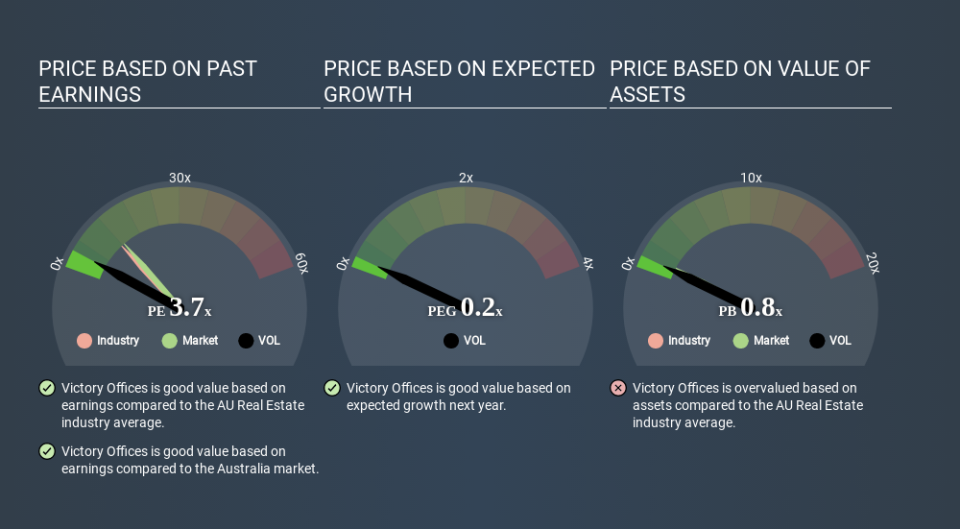What Is Victory Offices's (ASX:VOL) P/E Ratio After Its Share Price Tanked?

To the annoyance of some shareholders, Victory Offices (ASX:VOL) shares are down a considerable 41% in the last month. The bad news is that the recent drop obliterated the last year's worth of gains; the stock is flat over twelve months.
All else being equal, a share price drop should make a stock more attractive to potential investors. In the long term, share prices tend to follow earnings per share, but in the short term prices bounce around in response to short term factors (which are not always obvious). So, on certain occasions, long term focussed investors try to take advantage of pessimistic expectations to buy shares at a better price. Perhaps the simplest way to get a read on investors' expectations of a business is to look at its Price to Earnings Ratio (PE Ratio). A high P/E ratio means that investors have a high expectation about future growth, while a low P/E ratio means they have low expectations about future growth.
See our latest analysis for Victory Offices
Does Victory Offices Have A Relatively High Or Low P/E For Its Industry?
Victory Offices's P/E of 3.72 indicates relatively low sentiment towards the stock. If you look at the image below, you can see Victory Offices has a lower P/E than the average (11.6) in the real estate industry classification.
Victory Offices's P/E tells us that market participants think it will not fare as well as its peers in the same industry. While current expectations are low, the stock could be undervalued if the situation is better than the market assumes. You should delve deeper. I like to check if company insiders have been buying or selling.
How Growth Rates Impact P/E Ratios
Earnings growth rates have a big influence on P/E ratios. When earnings grow, the 'E' increases, over time. And in that case, the P/E ratio itself will drop rather quickly. So while a stock may look expensive based on past earnings, it could be cheap based on future earnings.
Victory Offices's earnings per share fell by 11% in the last twelve months.
Remember: P/E Ratios Don't Consider The Balance Sheet
It's important to note that the P/E ratio considers the market capitalization, not the enterprise value. So it won't reflect the advantage of cash, or disadvantage of debt. In theory, a company can lower its future P/E ratio by using cash or debt to invest in growth.
While growth expenditure doesn't always pay off, the point is that it is a good option to have; but one that the P/E ratio ignores.
How Does Victory Offices's Debt Impact Its P/E Ratio?
The extra options and safety that comes with Victory Offices's AU$641k net cash position means that it deserves a higher P/E than it would if it had a lot of net debt.
The Verdict On Victory Offices's P/E Ratio
Victory Offices trades on a P/E ratio of 3.7, which is below the AU market average of 12.6. The recent drop in earnings per share would make investors cautious, the relatively strong balance sheet will allow the company time to invest in growth. If it achieves that, then there's real potential that the low P/E could eventually indicate undervaluation. What can be absolutely certain is that the market has become more pessimistic about Victory Offices over the last month, with the P/E ratio falling from 6.3 back then to 3.7 today. For those who prefer to invest with the flow of momentum, that might be a bad sign, but for deep value investors this stock might justify some research.
Investors have an opportunity when market expectations about a stock are wrong. If it is underestimating a company, investors can make money by buying and holding the shares until the market corrects itself. So this free visual report on analyst forecasts could hold the key to an excellent investment decision.
Of course you might be able to find a better stock than Victory Offices. So you may wish to see this free collection of other companies that have grown earnings strongly.
If you spot an error that warrants correction, please contact the editor at editorial-team@simplywallst.com. This article by Simply Wall St is general in nature. It does not constitute a recommendation to buy or sell any stock, and does not take account of your objectives, or your financial situation. Simply Wall St has no position in the stocks mentioned.
We aim to bring you long-term focused research analysis driven by fundamental data. Note that our analysis may not factor in the latest price-sensitive company announcements or qualitative material. Thank you for reading.



